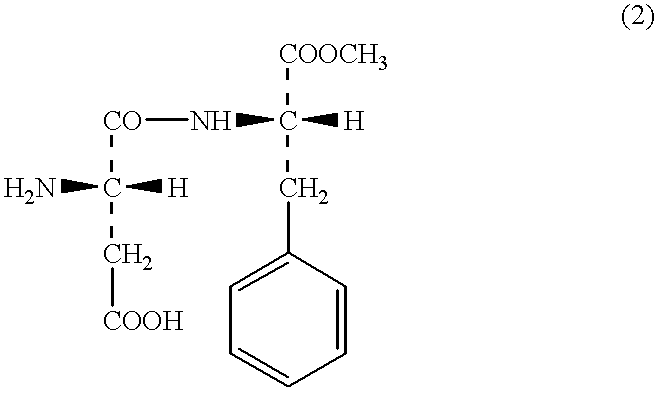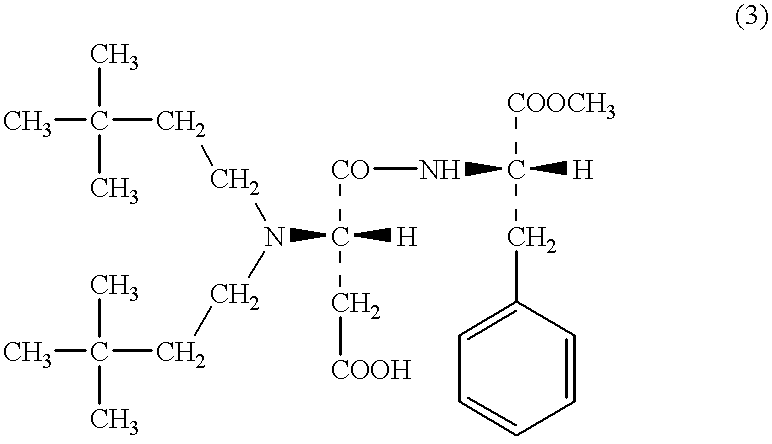Process for purification of aspartame derivative
a technology of aspartame and aspartame, which is applied in the field of purification of aspartame derivatives, can solve the problems of inability to obtain n-(3,3-dimethylbutyl)-apm having satisfactory purity, affecting the purity of aspartame, and causing fatness caused by excessive sugar intake and fatness, etc., and achieves the effect of easy purification
- Summary
- Abstract
- Description
- Claims
- Application Information
AI Technical Summary
Benefits of technology
Problems solved by technology
Method used
Image
Examples
example 1
According to the descriptions in the FR Pat. No.2697844 specification, 10.6 g of APM (aspartame), 5 ml of 3,3-dimethylbutylaldehyde and 1.6 g of sodium cyano borohydride were reacted in methanol and the resulting solution was concentrated under reduced pressure. To the mixture, water was added, and it was neutralized with the addition of 1N-HCl aqueous solution to precipitate an oily material. The material was extracted twice with 100 ml of ethyl acetate. Thus obtained organic layer was washed twice with 50 ml of water, and then washed once with 50 ml of a saturated aqueous solution of sodium chloride, and then dried over anhydrous magnesium sulfate. Then, the magnesium sulfate was removed by filtration, and the filtrate was concentrated. The resulting material was analyzed by the thin layer chromatography (TLC), and thereby it was found that APM was not contained therein. And however, N-(3,3-dimethylbutyl)-APM, N,N-di(3,3-dimethylbutyl)-APM and an unknown compound having a low pola...
example 2
According to the descriptions in the WO 95 / 30689 specification, 67.4 g of APM, 25 ml of 3,3-dimethylbutylaldehyde and 15 g of 5% palladium-carbon in a mixed solvent of methanol-0.1M acetic acid aqueous solution were reacted for three hours in a hydrogen stream. The catalyst was removed by filtration, and the catalyst was washed sufficiently with methanol. The filtrate and the methanol used in the washing step were combined together, and thus obtained solution was concentrated to adjust to about one third (1 / 3) of the solution in volume, and then 100 ml of water added thereto. Thus obtained mixture was concentrated further to precipitate crystals. The crystals were collected by filtration and analyzed by TLC. As a result, APM and N-(3,3-dimethylbutyl)-APM were detected, and however little (scarcely) N,N-di(3,3-dimethylbutyl)-APM was detected. On the other hand, in the mother liquor, which is thereafter referred to as "Mother Liquor 1", APM, N-(3,3-dimethylbutyl)-APM and N,N-di(3,3-di...
example 3
The Mother Liquor 1 obtained in the above-mentioned Example 2, was adjusted to pH 5 with the addition of 1N-NaOH aqueous solution and concentrated to about 100 ml of the solution. This mixture was extracted twice with 100 ml of ethyl acetate, and then the organic layer was washed with 50 ml of water. The organic layer was analyzed by TLC, and as a result, it contained little APM. In the same manner as in the Example 2, the solvent was replaced by a mixed solvent of water and methanol, and the solution was further concentrated to precipitate an oily material. The oily material was analyzed by TLC, and as a result, it was N,N-di(3,3-dimethylbutyl)-APM. The solution was washed twice with 50 ml of a mixed solution of ethyl acetate and ethyl ether in the ratio of 1:3, and concentrated continuously to precipitate crystals. The crystals were collected by filtration to obtain 4.0 g of N-(3,3-dimethylbutyl)-APM. The crystals were analyzed, and as a result little N,N-di(3,3-dimethylbutyl)-APM...
PUM
 Login to View More
Login to View More Abstract
Description
Claims
Application Information
 Login to View More
Login to View More - R&D
- Intellectual Property
- Life Sciences
- Materials
- Tech Scout
- Unparalleled Data Quality
- Higher Quality Content
- 60% Fewer Hallucinations
Browse by: Latest US Patents, China's latest patents, Technical Efficacy Thesaurus, Application Domain, Technology Topic, Popular Technical Reports.
© 2025 PatSnap. All rights reserved.Legal|Privacy policy|Modern Slavery Act Transparency Statement|Sitemap|About US| Contact US: help@patsnap.com



